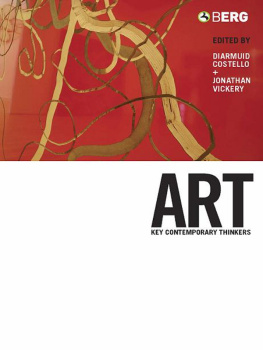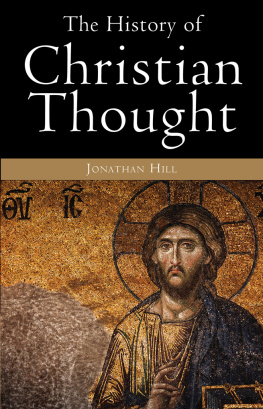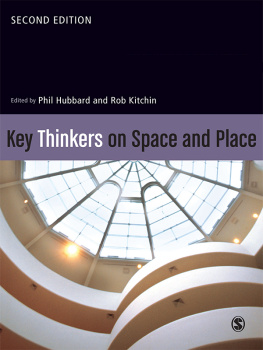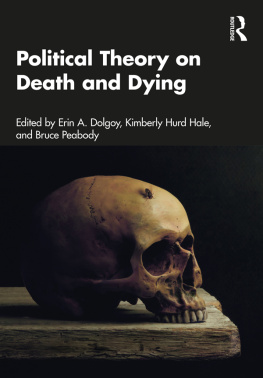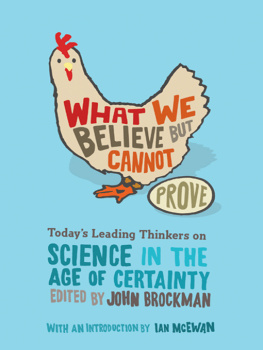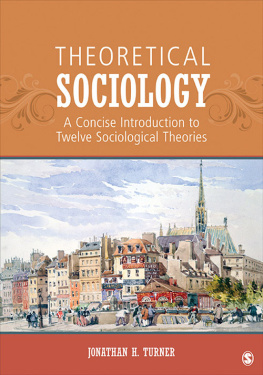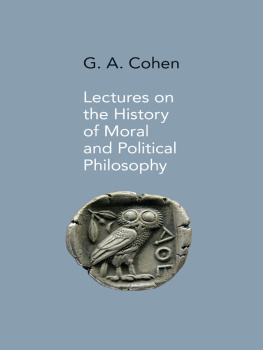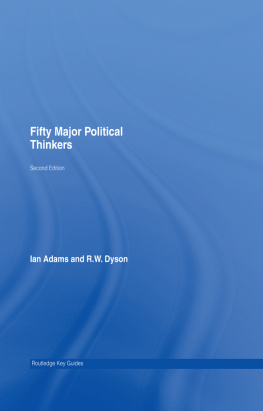
Art: key
contemporary
thinkers
Art: key
contemporary
thinkers
Edited by
Diarmuid Costello and
Jonathan Vickery
First published in 2007 by
Berg
Editorial offices:
1st Floor, Angel Court, 81 St Clements Street, Oxford, OX4 1AW, UK
175 Fifth Avenue, New York, NY 10010, USA
Diarmuid Costello and Jonathan Vickery 2007
All rights reserved.
No part of this publication may be reproduced in any form
or by any means without the written permission of Berg.
Berg is the imprint of Oxford International Publishers Ltd.
Library of Congress Cataloging-in-Publication Data
Art : key contemporary thinkers / edited by Diarmuid Costello and
Jonathan Vickery.
p. cm.
Includes bibliographical references
eISBN: 978-0-85785-077-5
1. Art, Modern20th centuryPhilosophy. 2. Art, Modern21st centuryPhilosophy. I. Costello, Diarmuid. II. Vickery, Jonathan.
N66.A76 2007
709.04dc22 2006031856
British Library Cataloguing-in-Publication Data
A catalogue record for this book is available from the British Library.
Typeset by JS Typesetting, Porthcawl, Mid Glamorgan
Printed in the United Kingdom by Biddles Ltd, Kings Lynn
www.bergpublishers.com
CONTENTS
Melanie Mario
Eric de Bruyn
John Welchman
Margaret Iversen
Michael Corris
Esther Leslie
Jonathan Vickery
Robert del Principe
Dominic Rahtz
Stewart Martin
Claire Bishop
Christine Mehring
Dominic Willsdon
Gregg Horowitz
Robert Williams
Gordon Hughes
Stephen Melville
Diarmuid Costello
Martha Buskirk
Riccardo Marchi
Francesca Berry
Kirstie Skinner
Michael Kelly
Espen Hammer
Katerina Reed-Tsocha
Stephen Mulhall
David Carrier
Darren Ambrose
Jonathan Lahey Dronsfield
Cain Samuel Todd
James Williams
Alex Potts 132
Ruth M. Sonderegger
Derek Matravers
Nancy Shawcross
Michael Richardson
Mike Gane
Helmut Schmitz
Gordon Fyfe
Rebecca Zorach
Scott Durham
David Ayers
Mignon Nixon
Sara Beardsworth
Francis Halsall
We would like to thank our commissioning editor Tristan Palmer at Berg for first proposing this project, and the contributors who made it possible. Their generosity, punctuality, and good-natured responses to numerous requests for clarifications and reformulations made a potentially hazardous project almost manageable. Particular thanks are due to Michael Richardson and Riccardo Marchi for contributing at shorter notice. Our gratitude also goes to D. J. Simpson, Hannah Jamieson, Sarah Shalgosky at the Mead Gallery, Warwick Arts Centre, and Sue Dibben at the Humanities Research Centre at Warwick University. The School of Arts & Humanities at Oxford Brookes University supported work on this project prior to Diarmuid Costello joining Warwick University, as did, indirectly, a Leverhulme Trust Research Fellowship. In a deeper sense, we are both indebted to the Departments of Philosophy and the History and Theory of Art at the University of Essex, in whose intense and congenial atmosphere the intellectual commitments that animate this volume were formed.
What different ways of interpreting art are there, and what different concepts and theoretical frameworks are involved? What is the value of art? How does art communicate, embody or otherwise express its meaning? Why does arts form and significance change over time, and within different contexts? Do changes in art reflect changes in culture and society as a whole, and if so how? These are questions that continually need to be asked and reassessed. Art itself is a discourse a conceptual field within which and around which move various kinds of objects, activities, processes, ideas and theories, subcultures and movements, institutions and exhibitions. The central characteristic of this discourse, particularly in its most recent forms, is its unstable, internally conflicted and often bewildering character. This can make trying to master the discourse of art a frustrating, but equally an intellectually exhilarating endeavour. Contemporary art in particular has never enjoyed such widespread interest and currency, yet the theoretical frameworks it produces and draws upon frequently remain opaque.
This book is a response to this situation, and is intended to put its readers in a position to explore and question theories, ideas and claims that they might otherwise be forced to take on trust. Of course no primer, however good, can replace reading the original texts. But in the case of those thinkers on art considered here, some introduction is necessary to understanding what one encounters when one does so. If this book sends its readers back to the originals with greater confidence and curiosity, and a better sense of how a given thinker sits within a wider field of overlapping debates, it will have served its purpose. To this end the collection brings together upcoming younger scholars with scholars of international standing to write in a way that is clear and approachable yet nonetheless challenging both for the reader and towards the thinkers and texts discussed. As such, the intention was always to lay the ground for further critical exploration on the part of the reader. Read in this spirit, in conjunction with the primary and secondary literature discussed, we believe that this collection will put its readers in a much better position to develop their own perspective.
The volume spans the ideas and theories of forty-five key contemporary thinkers on art. What counts as key, in this context, is a matter of both judgment and the audience we envisage, and in part hope to forge, through this collection. All such lists are partial, and there were a number of theorists whose work we were unable to cover in the space available, much as we would have liked to. By contemporary thinkers, we mean theorists who are associated with a coherent body of thought or ideas, which their work on art embodies or reflects, and whose work continues to impact on thinking about artistic practice, theory and historical analysis today. As such, we use the term contemporary in a fairly loose sense historically (roughly equivalent to since the 1960s), and to signify impact rather than origins. To pick an obvious example: Benjamin is hardly a contemporary thinker in biographical terms (he died in 1940), but his work has had an exceptional influence on art theory and criticism since the late 1960s. We take the 1960s as our point of departure because it is the locus of the most salient cultural transformation of our time the move from modernism to postmodernism. To the extent that we still inhabit postmodernism today or its aftermath today, this is the period of our contemporaneity, broadly conceived. This book is in part a cultural, philosophical and art historical roadmap of the ramifications of that transition.
The book is divided into four broad sections. These are in no sense meant to exhaust the range of discourses one can find represented in other books surveying the theory of art today. But given how widely areas not represented here (areas such as queer theory or postcolonial theory) have been covered elsewhere, we wanted to focus instead on broad bodies of thought around legacies of modernism and postmodernism in the arts. The first section is unusual, in so far as artists are typically neglected in anthologies of this kind. We have sought to redress this by including a section on artists as thinkers, that is, artists who have made a major contribution to thought about art since the 1960s through their writings as well as their art. Though one can find many anthologies of artists writings, one rarely finds artists treated on an equal footing with theorists, historians and philosophers when it comes to producing knowledge
Next page
